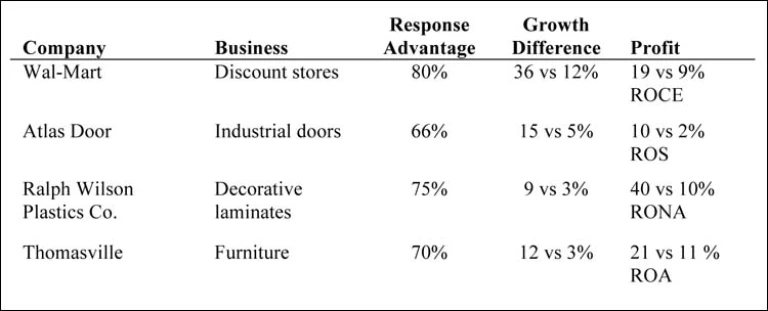Time is the secret weapon of business. Advantages in response time provide leverage for all the other competitive differences that make up a company's overall competitive advantage.
Many executives believe that competitive advantage is best achieved by providing the most value for the lowest cost. This is the traditional paradigm for corporate success. Providing the most value for the lowest cost in the least amount of time is the new paradigm for corporate success. An increasing number of companies are achieving success by establishing competitive response advantages. These time-based competitors belong to a new generation of companies that manage and compete in different ways.
New-paradigm companies:
- choose time consumption as a critical management and strategic measure;
- use responsiveness to stay close to their customers, increasing their customers' dependence on them;
- rapidly redirect their value-delivery systems to the most attractive customers, forcing their competitors toward the less attractive ones;
- set the pace of business innovation in their industries; and
- grow faster with higher profits than their competitors
The new generation of competitors is obtaining remarkable results by focusing its organizations on flexibility and responsiveness. The companies in the table below use their response advantages to grow at least three times as fast as their industries and to earn profits more than twice the average of their competitors.
Becoming a Time-based Competitor
You have become a time-based competitor when you have accomplished three tasks:
- Your value-delivery system is two to three times as flexible and responsive as those of your competitors;
- You have determined how your customers value these capabilities and have priced accordingly; and
- You have a strategy for surprising your competitors with your time-based advantage.
Make Your Value-Delivery System Flexible and Responsive
Most of the time a product or service is in your value-delivery system is spent waiting. Delays stem from these causes:
- procedural constraints, including minimum production or information-processing batch sizes, scheduling practices, and authorization schedules;
- quality problems, including physical and intellectual rework necessitated by inadequate design and attention to details; and
- structural difficulties, including convoluted flows of product and information, functional handoffs, and interrelated facilities located at different sites.
The single greatest cause of inflexibility and slow responsiveness, though, is organizing for economies of scale and control rather than for fast throughput.
To improve its responsiveness a company needs to organize for economies of time and for visibility. To do so, many companies disassemble their functional organizations and reassemble them into permanent, multifunctional teams. The members of these teams focus on entire processes, products, projects, customers, and/or competitors. The teams include everyone who can slow or speed the process and are often in one location. Their performance measures are set to achieve goals rather than efficiency.
One consumer appliance manufacturer formed development teams and challenged them to reduce the company's development cycle from as much as three years to less than 12 months. The teams identified many opportunities. For example, they found that months could be cut from the cycle by transferring several performance tests from the company's central testing laboratories to the design team organization. As the result of such changes, the company is well on its way to achieving its goal.
Price for Value Provided to Your Customers
The customers of time-based competitors obtain special value, although sometimes they do not recognize the value of faster response right away. Flexible, faster response benefits your customers in a number of ways:
- They need less inventory;
- They can make purchase decisions closer to the time of need;
- Their customers are less likely to cancel or change their orders;
- Their cash flow cycle is speeded up; and
- They receive more special services and customized products.
These and others benefits affect customers' economics, thus creating value. Time-based competitors retain some of this increased value in the form of increased prices and market share. For example, a manufacturer of a commodity product improved its responsiveness and is gaining share while earning a 20 percent price premium. Its distributors can pay higher prices and still make more money, because their inventory turns four times as fast as the industry average.
Improved responsiveness creates greater customer dependency and thus increases market share. A supplier of a custom industrial product could not increase its share of customer purchases using traditional means but did so after reducing its response time by 75 percent on every order, including semicustom fabrication. As customers became confident that they could rely on this company as a sole supplier, its share of their purchases increased from 30 to 45 percent.
Surprise Your Competitors
The greatest risk you run in becoming a time-based competitor is that one of your competitors might become one simultaneously. If you increase your responsiveness at equal rates, any advantage either of you achieves will be arbitraged away in the marketplace and only your customers will benefit.
True value and additional profits result only if you can establish a substantial response advantage over your competitors that will be difficult if not impossible for them to close. You can do this by:
- initiating and executing a determined program to reduce delays in your organization;
- not passing the benefits on to customers until those benefits are substantial, i.e., not tipping your hand early;
- focusing your marketing and sales resources on the customers that will benefit the most from improved responsiveness and thus be willing to pay a price premium;
- buying time by diverting your competitors' interest in the changes you have made; and
- preserving your lead by continuing your internal efforts to improve responsiveness.
The Importance of Vision
The journey to becoming a time-based competitor is demanding. It must begin with a vision of what could be. The vision needs to be sufficiently clear and attractive to motivate you and your organization to rethink the structure and activities of your whole value-delivery system, so as to maximize its performance.
Initiating and executing a program that improves the responsiveness of an organization rapidly is not easy. Such a program must compete with other programs for attention. Further, the job is difficult to delegate to your subordinates, because improving responsiveness requires breaking down rigidities and delays across, as well as within, functions. Thus, you must stay involved. Finally, sustaining the rate of improvement and the accompanying benefits necessitates a philosophical change. Top management must shift its focus from cost to time, and its objectives from control and functional optimization to providing resources to compress time throughout the organization.
You, as the keeper of the vision, must believe that time is your number-one competitor.

